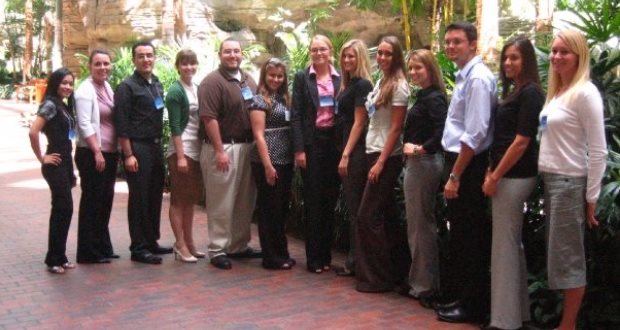Attracting Millennials: Are You Thinking Age-Appropriately?
By Tara Ericson and Kelly Clark

Attracting millennials to your association requires thinking about the different life stages they are living through — and marketing to them appropriately.
A lot of articles out there dispense quick advice about how to attract millennials to your association’s membership: reach them on social media! Give them leadership positions right away! Make your meetings more social!
While some of that advice might gain younger members for your association, let’s pause to think about a basic millennial truth: some millennials are full-on grown-ups with jobs, spouses and kids, while some are still in high school.
Which leads to a couple questions your board should be asking itself when thinking about attracting millennial members: when it comes to marketing membership in our association to millennials, are we thinking age appropriately?
[
Millennials range in age from 16 to 35. One-size-fits-all membership marketing doesn’t work. ![]()
Targeting older millennials for membership? Focus on leadership opportunities, job skills, & power to make social change. ![]()
Targeting younger millennials for future membership? Attend career fairs/teach-ins, educate about your industry, offer internships. ![]()
Younger vs. older millennials
Most articles about millennials lump them into one big generation and project the same traits, goals and habits on them all. But consider this: most definitions of the millennial generation include people born between 1981 and 2000. This means we’re talking about people who are 16- to 35-years-old.
Think about a 16-year-old you know: they’re in high school. They might have their first job lifeguarding or serving food, which earns them spending money for weekends and dates. Their current goals likely involve passing chemistry, getting a driver’s license and a car and scoring a date to the homecoming dance. Life past high school is two years away, but they don’t need to think about that now. They are just as likely to have an ambitious vocational goal in mind as they are to have no idea what they want to do with their lives after graduation day.
Now think about a 35-year-old you know: hopefully, they’re gainfully employed and have been for several years. This enables them to pay their rent or mortgage. They might be married with kids to support. Their current goals likely involve paying off loans, whether it’s for their dwelling, their car or student loans — or maybe a hospital bill incurred when their kid broke their arm last month — and advancing their professional knowledge so they can get a promotion, earn additional money for their family and achieve a sense of self-actualization. They’re looking forward to their Caribbean vacation next month, but they’re also diligently saving money to their 401K account for retirement decades from now.
Quite a different set of priorities than the 16-year-old, yes?
So why would your association apply a one-size-fits all membership marketing strategy to try and appeal to both ends of the millennial age spectrum?
You will be much more likely to successfully attract millennials to your association if you customize an age appropriate campaign. If your association creates a few membership marketing strategies that account for the different phases of life members of this generation are living through, you’ll be much more likely to position your association as a must-belong organization for a wider professional demographic.
Older millennials are ready to jump in now
Right now, older millennials are roughly ages 26 to 35. The vast majority have graduated from college, post-graduate school or vocational training. They’re well past their first job; or, if they still work at their first job, they are well-established in their position. If they have stuck with their intended career path, they are probably looking to keep their skills current while working their way into higher leadership positions. If they are new to the profession — they’ve had a change of heart about what they want to do for the next 40+ years after getting a taste of working life, or they’ve realized that sociology degree didn’t earn them the salary they dreamed of — they’re looking for solid footing and friends who can help them navigate their new field.
Marketing association membership to older millennials
Associations compete with social media, with 24/7 news and with other tech-based distractions that they didn’t have to compete with in the past when trying to get the attention of potential members. Plus, they’re still competing with other industry groups or associations for potential members’ funds and interest.
Joe Rominiecki has penned a succinct, three-part list of tips for attracting millennials: showcase your diversity, focus on job skills and empower them to create social change:
- Show that you’re not a monolithic group. The millennial generation is just 61 percent white, and women earned 60 percent of all college degrees awarded in 2010. The more people see that your association reflects their demographic, the more likely they will feel comfortable enough to join.
- Focus on job skills. Associations must be a source for lifelong learning and skills training, because between financial and familial responsibilities, going back to college is often not an option. Skills such as work-life balance, negotiating salaries and how to become a visionary (for yourself or for others) are especially in demand with millennials because they’re not often taught in a classroom. Research by Deloitte confirms that millennials want leaders focused on “soft” concerns such as well-being and employee development. Respondents’ top traits of “true leaders” were the ability to inspire, vision, decisiveness and passion.
- Empower social change. Millennials seek to improve the world around them through direct action. “How do you show young people that you are into the community, living a purposeful brand?” Martin says.
Possible tactics for attracting older millennials to your association
- Maintain active job boards. In-person relationship building at your events and programs will remain important to millennials, but they conduct a lot of their lives online and enjoy the anonymity of the Internet. Your industry-specific job board is where older millennials are going to find their next job.
- Offer the opportunity for a young professional to shadow someone in your industry for a day. They could be considering a career change, or they may want to see in-person what their career’s next level could look like. Most millennials consider this type of short-term mentoring invaluable.
- Offer free resources for job seekers that can turn them into members:
- Resume critique
- Job boards
- Certification programs
- Workshops
- Appeal to their sense of social responsibility; the desire to “give back” is a strong millennial trait, and most want to interact with brands that not only share their values, but also are a force for good in the community. Whether through Corporate Social Responsibility (CSR) initiatives or showcasing members’ individual contribution to others and the industry, associations with a clear purpose that stand for something larger than themselves will easily attract the millennial crowd.
- Offer graduated leadership opportunities. Are there ways older millennials can become involved in your association past basic membership once they join? Millennials join associations for the same reasons as other generations: to build relationships, to enhance their professional skill set and to have an opportunity to shine as a leader. Some will be ready to take on high-profile, high-involvement positions such as a board position or an event chair. However, others are balancing their existing familial or social obligations, and while eager to serve, can only take on a smaller role for the time being. Offer multiple leadership roles of varying commitment levels. This way, your association can meet the needs of all older millennials wanting to be professionally active while respecting the multiple demands on their time and energy.
Ask your board:
- What have we done to attract older millennials as employees or as members?
- How can we show off the benefits of belonging to our association?
- What are some successful channels we’ve used to market membership to millennials?
- What opportunities for leadership or further involvement do we offer? How much time and effort do those opportunities require, and can we vary them?
- What obstacles outside our association or industry’s realm might be preventing older millennials from becoming members, and what can we do to help remove them?
Younger millennials aren’t ready to join, but they’re open to suggestions
Your typical younger millennial is in high school or college or is new to the workforce. They might have a general sense of what type of work they want to be when they’re an adult, but most are still looking at career options. Many don’t realize their chosen profession or trade has an association to which they could belong, find others like them and learn new things. If they do realize association membership is an option, they may not have joined yet because their employer doesn’t cover association dues and they don’t have the extra funds themselves — or they don’t realize the benefit of investing in an association membership and don’t want to pay dues.
Marketing association membership to younger millennials
When thinking about how to attract younger millennials to your association’s membership roll, shift your mindset to that of a high school or college student. Was joining an association at the forefront of your mind? Was the thought of attending professional programs in the same room as people with 20 more years of experience than you intimidating? Was paying membership dues a priority for you at age 22?
Overall, younger millennials don’t think about joining associations. They’ve barely decided what they’re going to do for work for the bulk of their lives! What can you do to plant the seed of membership or a career in your industry? Consider these practical suggestions:
- Make a habit of attending college or high school career fairs. Younger millennials might not be old enough to hold down a job in any given field but they should at least be thinking about it, and who better to encourage them to choose your field than your most successful, exuberant members? Just like older millennials, younger millennials trust individuals more than corporations or brands.
- Post educational content about your industry on your website. Be a resource for students considering a career in your industry or profession. Lay out concrete, practical steps a young millennial can take now to start preparing for a successful, satisfying career. Point them toward other organizations or resources, too — millennials value being on a team and collaborating with others. Show them that your association plays nice with others, and when they’re old enough to become a member, they’ll remember you as a cool aunt they want to hang out with and not the crotchety geezers who want to keep them off your lawn.
- Establish mentoring programs. According to Virtuali and the New Leadership Council, millennials value people-centric leadership. According to their survey respondents, the most important leadership qualities to the millennial generation are communication, the ability to build relationships and the ability to develop others. While long-term mentoring programs can provide fantastic professional and personal value to mentees as well as mentors, a mentoring program doesn’t have to span months to provide value to potential members. The Gainesville Chapter of the Florida Public Relations Association held a public relations Shadow Day, where PR students from two local colleges were matched with local PR professionals and shadowed them for a day at their workplace. Students were invited to keep in touch with their one-day match.
- Attend teach-ins. Similar to exhibiting at career fairs, teach-ins at universities, high schools and even middle schools can spark interest in your industry and association. When students see a real person talking animatedly and positively about their work and how they arrived at their position, their salary and their lifestyle, they leave the classroom with a positive impression that can alter their future work plans — and direct their steps toward your association at a future date.
- Help your existing members offer internships (especially ones that can lead to full-time positions). Internships act as marketing piece for a business and an association. Students often make basic decisions about whether or not to pursue a career path based on their internship experience. Give your members the resources they need to host a meaningful internship for students and you’ll reap future association members when those interns transition into full-time work in your industry.
Ask your board:
- What have we done to attract younger millennials as employees or as members?
- What internships can we offer in our own association office?
- What members can we invite to participate in mentoring and internship programs?
- How can we get more seasoned members involved to help attract younger members?
Invest in millennials today — sign them on as members tomorrow
Marketing association membership to millennials isn’t complicated and it’s not mysterious. Take some time to think about where in life different cohorts of millennials are living and working, and how your association can respond to their different career stages. Associations that provide solutions to millennials’ needs today will be the ones that most frequently sign them on as members tomorrow.
Tara Ericson is a group vice president at Naylor Association Solutions where she oversees Group Publishers and specialized industry market teams, whose primary focus is to ensure Naylor’s association partners are consistently achieving their non-dues revenue goals.
Kelly Clark is the manager for online marketing with Naylor Association Solutions, and an older millennial.



